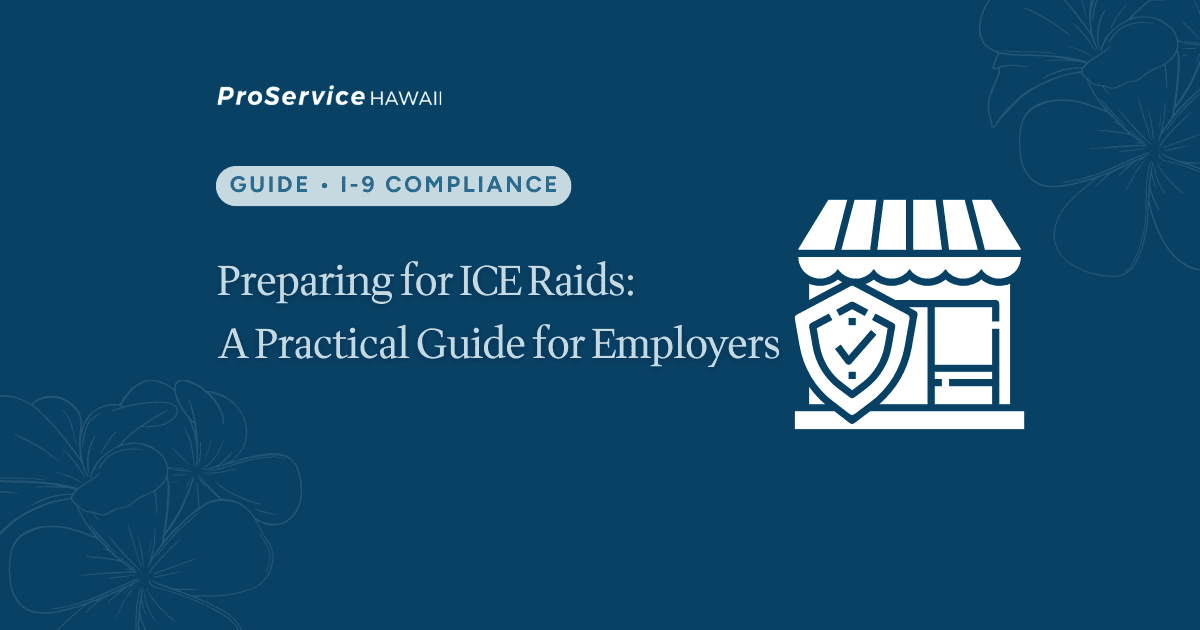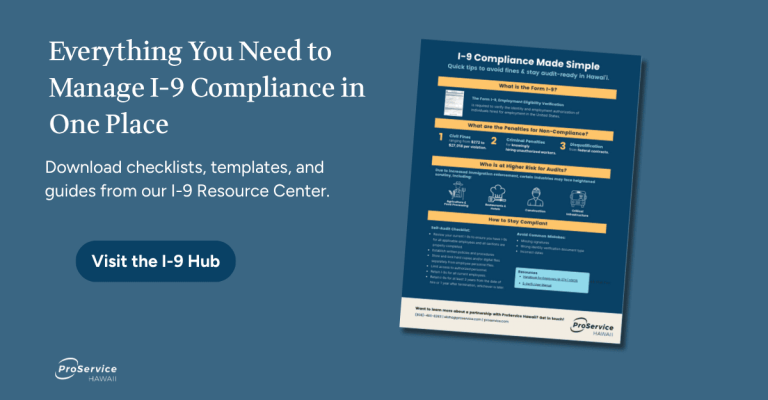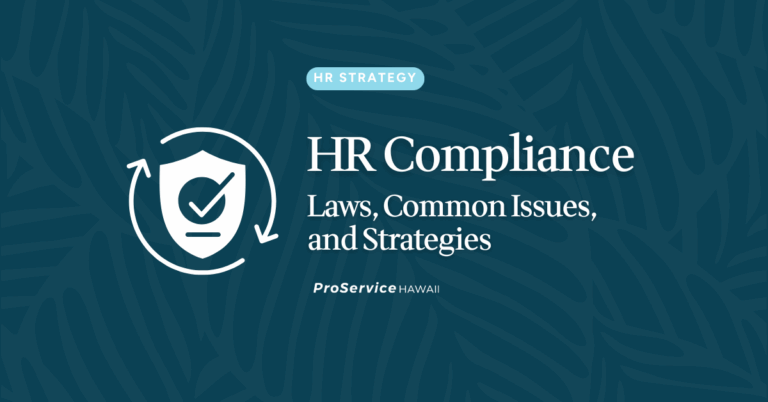Preparing for ICE Raids: A Practical Guide for Employers
Immigration enforcement is rising, and employers across the U.S. are feeling the pressure. From surprise workplace immigration raids to formal I-9 audits, Immigration and Customs Enforcement (ICE) is intensifying its scrutiny of employer compliance. For HR professionals and business leaders, preparation isn’t only about avoiding penalties; it’s about protecting what you’ve built.
In Hawaii, immigration enforcement has been focused on hotels, restaurants, construction sites, and farms. If you're running a business here, you've probably heard the stories from other owners who got caught off guard. Agents often arrive unannounced, bringing business operations to a complete stop. Suddenly, the business owner faces massive fines that can cripple their business.
You need to know what to expect and how to respond before ICE shows up at your door. This isn't just about following rules—it's about keeping your employees safe, your business running, and avoiding financial disaster.
This guide walks you through everything you need to know, including how to prepare your team and exactly what steps to take during and after a raid or audit. You'll learn how to protect both your business and your employees' rights without making costly mistakes that could have been easily avoided.
With guidance and preparation, you can face any workplace immigration audit with confidence.
Workplace Immigration Enforcement Basics
Before you can start putting protective measures in place, you have to understand exactly what you're dealing with. ICE uses specific tools and tactics they use to target businesses, and each one requires a different response strategy. The more you know about how these enforcement actions work, the better you can prepare your team.
Let's break down what ICE does, what triggers audits or raids, and what’s at stake if your business isn’t prepared.
What is ICE?
Immigration and Customs Enforcement (ICE) is the federal agency responsible for enforcing immigration laws within the United States. Its primary goal is to ensure that businesses only employ individuals authorized to work in the country.
In the workplace, ICE primarily acts through two channels: Form I-9 audits (paperwork-based) and workplace immigration raids (surprise visits, where agents may show up unannounced). Both are designed to verify that employers are hiring and retaining individuals who are legally authorized to work in the country. Both aim to verify employment eligibility—but they differ in scope, urgency, and impact.
Whether it’s an audit or a raid, ICE enforcement can create serious disruption for unprepared employers. Knowing how each process works is the first step toward protecting your people and your business.
What is a Form I-9 audit?
Every employer in the U.S. must complete a Form I-9 for each employee they hire. This form verifies both identity and authorization to work in the U.S. Employers must review the supporting documents, complete all required fields, and securely store the form for every active employee.
ICE conducts I-9 audits to verify employment records. ICE agents will examine every form for errors, missing information, or inconsistencies that could signal potential violations. They often examine patterns—such as incomplete sections, missing signatures, or repeated use of similar documents across multiple employees.
Even small paperwork mistakes can add up to significant penalties, so consistent record keeping and regular internal reviews are critical to maintaining compliance.
What is a workplace immigration raid?
A workplace immigration raid happens when ICE agents show up at your business without any warning. They typically arrive during peak hours—early mornings, shift changes, or busy periods when most employees are present—to maximize the number of workers they can question.
Agents can enter public areas of your workplace—such as lobbies, reception areas, or customer spaces—without permission. However, private areas, such as offices, employee-only zones, or production floors, require a judicial warrant signed by a federal judge. Understanding this distinction is essential for maintaining control and protecting your team’s rights.
During a raid, ICE agents will directly question employees about their immigration status and demand to see work authorization documents on the spot. If workers can’t immediately prove authorization, agents may detain them. The disruption can halt business operations for hours or even days, creating confusion and fear across your workforce. Unlike I-9 audits, which focus on paperwork, raids target individuals for immediate arrest and detention and are more disruptive and impactful.
The best defense is preparation. Having a clear, rapid response plan, trained managers who know how to engage respectfully with ICE, and employees who understand their rights can make all the difference. Preparedness keeps your business protected when it matters most.
What are the Potential Employer Penalties for Immigration Violations?
The penalties for immigration violations can be devastating, both financially and operationally. Here’s what employers may face if ICE identifies compliance issues during an audit or raid:
- First-time paperwork violations: $250 to $2,500 per employee
- Repeat paperwork violations: $2,500 to $5,000 per employee
- Knowingly hiring unauthorized workers: $5,000 to $25,000 per employee
- Criminal charges: Up to 6 months in prison for repeat violators
- Business license suspension: State licenses can be revoked for violations
- Ongoing ICE monitoring: Mandatory compliance reporting for repeat offenders
- Loss of government contracts: Automatic disqualification from federal work
Beyond the immediate fines, you may be left dealing with operational disasters that last for months. Employee morale crashes when coworkers get arrested during raids. Remaining workers may quit out of fear, leaving you to scramble for replacements in Hawaii's already tight labor market. In local business communities, news spreads fast, and reputation damage can hurt your ability to attract both customers and quality employees for years.
A professional employer organization (PEO) helps you avoid these penalties by maintaining proper I-9 systems, conducting regular internal audits, and providing expert support when ICE conducts an audit. The cost of prevention through a PEO partnership is always much less than paying massive fines and rebuilding your business after an enforcement action occurs.
How to Prepare for Workplace Immigration Raids and Audits
Being proactive is the best defense. A thoughtful, well-practiced plan helps your business stay compliant and operational when enforcement happens. The key is taking a multi-layered approach that covers preparation, documentation, training, and employee communication, long before ICE ever arrives.
Let's walk through the specific strategies that will keep your business ready for an ICE audit or raid.
Create a written rapid response plan
Your rapid response plan is your playbook during crisis moments when everyone is panicking and ICE agents are asking questions. This written document should clearly identify which managers are authorized to interact with ICE agents, outline communication protocols, and list contact information for your legal counsel and HR leaders. Everyone in your organization should know who these designated contacts are. The plan needs to be detailed enough that any manager can follow it under pressure.
Designate a primary contact person and at least two backups in case your main point of contact is unavailable when ICE arrives. Include your lawyer's emergency contact information, key employee contact lists, and locations of all important documents. Store copies of the plan along with key employee and attorney contacts in multiple secure locations.
Running practice simulations with your management team is crucial for ensuring your plan is effective. Schedule mock raids every six months where managers practice their roles, test communication systems, and identify weaknesses in your procedures. Practicing will help identify gaps, refine communication, and help everyone keep their composure during the real event.
Perform internal I-9 audits
Think of internal I-9 audits as your early warning system. The goal is catching and fixing errors before ICE does, and shows good-faith compliance if you are inspected.
Conduct quarterly reviews to confirm every form is complete, accurate, and up to date. Check for missing signatures, expired documents, or inconsistencies. Create a simple tracking system for document expiration dates and ensure employees renew paperwork before it lapses. Document everything during your internal audits. Keep records that show when you conducted reviews, what problems you identified, and how you corrected them.
A clear paper trail demonstrates that you're taking compliance seriously and can significantly reduce penalties if any violations are identified. Well-organized records also make it much easier to respond quickly when ICE delivers that three-day notice for an official audit.
Train staff on compliance
Your managers and HR staff need comprehensive and ongoing training on I-9 requirements because they're your first line of defense. Training should cover how to properly complete I-9 forms, which documents are acceptable for proving work authorization, and how to identify potential red flags without crossing into discriminatory territory.
Include training on recognizing when employees may lack proper authorization—like when documents look suspicious or employees can't provide the required paperwork. However, be careful to train staff on what they can and cannot ask about. You can request specific documents listed on the I-9 form. Still, you cannot demand particular documents or ask questions that could be seen as discriminatory based on national origin, citizenship status, or accent.
Because immigration law changes frequently, schedule regular training updates at least twice per year. Include real-world scenarios specific to Hawaiian businesses, like dealing with employees who have temporary work visas for seasonal tourism jobs. Your training should also cover the differences between I-9 audits and workplace raids so managers know what to expect and how to respond appropriately to each situation.
Ensure employees know their rights and how to respond
Educate every employee on what to do during an ICE encounter, no matter their immigration status. When employees understand what's happening and know their options, they're less likely to make decisions that could hurt themselves or your business.
All employees have specific rights during ICE encounters, regardless of their immigration status.
Employee Rights During ICE Encounters:
Employees don't have to answer questions about immigration status, nationality, or citizenship.
Employees can request to see warrants before allowing access to non-public areas.
Employees can request to see warrants before allowing access to non-public areas.
Employees can request to see warrants before allowing access to non-public areas.
They don't have to sign anything without understanding what it means.
How to Handle an ICE I-9 Audit
An I-9 audit starts the moment you receive a Notice of Inspection (NOI) from ICE. You have exactly three business days to comply, and how you manage those 72 hours can make the difference between minor penalties and business-crushing fines. Here’s how to navigate the process step-by-step:
The Complete I-9 Audit Process
Day 1 – Notice of Inspection arrives: ICE delivers NOI requiring all I-9 forms and supporting documents within 3 business days
- Immediately contact legal counsel: Call your employment attorney within hours of receiving the notice
- Notify your HR team or PEO partner: Get expert support to help gather and organize documents
- Review the NOI carefully: Understand exactly what ICE is requesting and the specific deadline • Create a document tracking system: Set up a method to track what you're providing to ICE
- Begin gathering all I-9 forms: Collect every I-9 for current employees and recently terminated workers
Day 2-3 – Document preparation: Review each form for completeness, make copies of everything
- Submit documents to ICE: Deliver all requested materials before the 3-day deadline expires
- ICE reviews your submissions: Agents examine forms for errors, missing information, and unauthorized workers (timeline varies: 30-90 days)
- ICE issues findings: You receive Notice of Intent to Fine (NIF) if violations are found, or case closure if compliant
- 30-day response period: You have 30 days to respond to NIF with corrections or explanations Final ICE determination: ICE issues Final Order with final penalties or case closure
- Potential follow-up actions: If unauthorized workers are found, ICE may require termination and ongoing monitoring
Best Practices During an Audit:
- Act fast and stay organized from the moment that notice arrives. Contact your employment lawyer immediately—don't try to handle this alone. Your attorney can review the Notice of Inspection to ensure you understand exactly what ICE wants and help you avoid providing more information than legally required. They can also guide you through the response process if violations are found.
- Reach out to your HR outsourcing provider or PEO partner right away as well. They have experience with I-9 audits and can help you quickly gather and organize all the required documentation. Having professional HR support during the audit process reduces your risk of making mistakes that could increase penalties. They can also help ensure your I-9 practices are properly updated to prevent future violations.
- Keep detailed records of everything you provide to ICE. Make copies of all I-9 forms and supporting documents before submitting them, and maintain a log showing exactly what was delivered and when. This documentation protects you if there are disputes about what was provided or if ICE claims documents are missing. Having organized records also makes it easier to respond if ICE finds issues and requires additional information.
- Be cooperative, but don't volunteer extra information beyond what's specifically requested in the notice. Answer ICE's questions directly and provide the exact documents they're asking for, but avoid offering additional records or explanations that weren't requested. This approach demonstrates good faith compliance while protecting your business from unnecessary scrutiny. Remember that everything you say and provide can be used in determining penalties, so professional legal guidance is essential throughout the entire process.
[Infographic placement suggestion: “ICE I-9 Audit Timeline – From Notice to Resolution” showing the key steps and timeframes in a visual format]
How to Respond to Workplace Immigration Raids
If ICE agents arrive unannounced, the situation can feel overwhelming. Preparation and having a clear plan in place are essential. Remaining professional and respectful throughout the process helps minimize disruption and demonstrates cooperation, while also protecting the organization’s rights. Ask For and Review the Warrant. If agents claim to have a warrant, you are entitled to examine it before granting access to private areas. A valid judicial warrant must:
- Be signed by a federal judge, not just an ICE supervisor.
- Clearly list your business address and specific search areas.
- Include an official court seal or case number.
Take a moment to read it carefully. If information appears incorrect or incomplete, note your concerns but don’t argue on the spot. Instead, document everything for later review by your attorney. Request a copy of the warrant—or take a photo for your records.
Monitor and Document ICE Actions
Assign one trained manager to observe and record ICE’s actions throughout the raid. This person should take detailed notes about:
• Which areas agents accessed
• Which employees were questioned or detained
• What documents were requested
• The names and badge numbers of agents present
• The time the raid began and ended
Monitor and Document ICE Actions During the Raid
Assign a manager to follow ICE agents and document everything they do throughout the raid. This person should take detailed notes about which areas agents accessed, what questions they asked, how they treated employees, and whether they followed proper procedures. Use your phone to record video if possible—there's no law preventing you from filming ICE actions on your own property.
- Document which employees were questioned, what documents agents requested, and whether any workers were detained or arrested. Note the time of arrival, badge numbers of agents, and how long the raid lasted. This information becomes crucial if you need to challenge ICE's actions later or if employees file complaints about treatment during the raid. Keep this documentation secure and provide copies to your attorney immediately after agents leave.
- The manager documenting should stay visible to ICE agents but avoid interfering with their work. They should remain professional, answering only direct questions while continuing to observe and record. This creates a legal record that protects both your business and your employees' rights during what can be a chaotic and frightening situation.
- Above all, stay calm and aligned with your plan. A steady, well-prepared response demonstrates that your business is cooperative, compliant, and well-managed.
Your behavior sets the tone for how the entire raid unfolds. If you panic or become confrontational, agents will respond more aggressively, and your employees will become even more frightened. Take a deep breath, speak slowly and clearly, and remember that everything you say can be used against you later. Stay professional even if agents are being demanding or rude.
Immediately activate your rapid response plan by contacting your designated point person and legal counsel. Don't try to handle this alone, even if agents are pressuring you to make quick decisions. Tell ICE agents that you're cooperating fully but need a few minutes to contact your attorney. This isn't obstruction—it's protecting your business. Keep your hands visible at all times, avoid sudden movements, and never physically interfere with agents' activities.
What to Do After a Workplace Immigration Raid
As soon as agents leave, contact your employment attorney to review what happened—what documents were taken, who was questioned or detained, and whether proper procedures were followed. A prompt legal review can identify rights violations or errors that may shape your next steps.
Next, notify your HR outsourcing provider or PEO partner. They’ve handled these situations before and can help you navigate post-raid challenges, from managing payroll for detained employees to maintaining compliance during ongoing investigations.
While details are still fresh, document everything: timelines, badge numbers, agent names, questions asked, and any materials taken. Your attorney will need these details to assess whether ICE followed proper procedures and to prepare for any follow-up enforcement actions.
Use the raid as a learning opportunity to examine weaknesses in your compliance system and identify what might have triggered ICE’s attention, such as incomplete I-9 forms, expired documentation, or procedural gaps. Conduct an honest assessment of what went wrong and fix those problems immediately before ICE returns for follow-up inspections.
- Review every I-9 form in your files with fresh eyes. Look for the types of errors or red flags that might have attracted ICE attention in the first place. Check for missing signatures, expired work authorization documents, or employees who might have provided questionable documentation during hiring.
- Update your hiring procedures to catch these issues before they become compliance violations.
- Strengthen your rapid response plan based on what actually happened during the raid. If managers panicked or didn't know who to call, fix those communication gaps. If employees were confused about their rights or made statements that could hurt your business, improve your training programs. This proactive review demonstrates to regulators—and to your employees—that your business takes compliance seriously.
Employees who witnessed a raid may feel scared, confused, and uncertain about the future. You need to address their concerns quickly and honestly to prevent your workforce from completely falling apart. Hold a team meeting within 24-48 hours to explain what happened, reassure staff about job security, and provide clear information about next steps.
Share trusted legal and community resources, such as local immigration attorneys or employee assistance programs, especially if coworkers were detained. Providing this support builds trust and shows genuine care for your team’s well-being.
Be transparent about operational changes. If certain positions need to be filled quickly or if work schedules will be disrupted, explain this clearly. Employees appreciate honesty about challenges while also needing reassurance that the business will survive and their jobs remain secure.
If word about the raid spreads to customers, suppliers, or the media, you need a prepared response that protects your business reputation. Don't ignore external communications—silence can be interpreted as guilt or mismanagement. Develop key messages that emphasize your commitment to compliance, cooperation with authorities, and continued business operations.
Focus your external messaging on facts rather than emotions. Acknowledge that the raid occurred, state that you're cooperating fully with authorities, and emphasize steps you're taking to ensure ongoing compliance. Avoid detailed explanations that could be misinterpreted or provide information that might hurt you legally. Keep statements brief and professional.
In Hawaii's tight business community, reputation damage from immigration raids can spread quickly, harming your ability to attract customers and quality employees. Consider reaching out proactively to key business partners, major customers, and community leaders to provide your perspective before they hear distorted versions from other sources. Quick, honest communication often prevents bigger reputation problems down the road.
Preparation Is Your Best Protection Against Workplace Immigration Raids and Audits
Immigration enforcement is expected to remain a federal priority—and that means Hawaiʻi employers must stay ready. Businesses that take a proactive, well-documented approach to compliance can minimize risk, protect their teams, and maintain operational peace of mind.
Partnering with ProService Hawaii gives you access to local experts who understand both federal requirements and the realities of doing business in our islands. From maintaining accurate I-9 systems to training your managers and employees, our HR professionals help you stay compliant—so you can focus on what matters most: your people and your business.
Our team of local HR specialists provides hands-on guidance across every area of compliance, from hiring and documentation to audits, payroll, and dispute resolution. On average, our clients across 375+ industries save more than 80 hours each month by partnering with ProService.
At ProService, we believe preparation is protection. Understanding the I-9 process and having a plan in place can make all the difference when ICE comes knocking. Our HR experts can help you navigate every step — before, during, and after an audit — so you can focus on running your business with confidence.
Contact ProService Hawaiʻi today to discover how our local experts can help safeguard your team, reputation, and bottom line.








